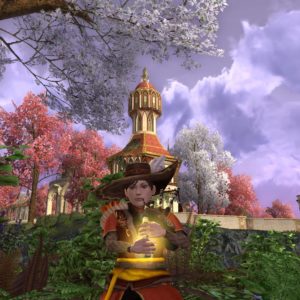Hobbits to Elves
By Cyndars
February 20, 2019
After completing her walk through the Shire, I chose to take Cantarlina from Needlehole to Duillond, one of the homes of the elves. I encountered an unexpected problem with my theory that the music would transition smoothly between zones. Transitioning between Needlehole and Duillond requires passing through a “doorway” with a loading screen, unlike the transition between Stock, in the Shire, and Buckland, in Breeland.
Once Cantarlina had passed through the loading screen and into Ered Luin, I noticed that the music did contain orchestral strings, playing at a significantly more dignified pace than the music in the Shire. Rather than feeling that Cantarlina was attending a county fair, I instead felt that Cantarlina might have been attending a symphony. None of the pieces are long enough on their own to count as an actual symphony, but the feeling is that the music could have come from the Romantic composers like Tchaikovsky or Brahms. The music is very emotional while maintaining the dignity that is associated with the orchestral performances.
In order to proceed through Ered Luin properly from the places of the Elves, I took Cantarlina from Duillond to Celondim. Once in Celondim, I was reminded again of the history of the elves. For those who are familiar with Tolkien’s Silmarillion, the tragedy of the elves is two-fold. First, the history of the elves is fraught with death and destruction. They created and experienced unsurpassed beauty and goodness in Valinor (those that went), and survived the loss of that beauty and goodness. They endured the kin-slaying, ship-burning, and other tragedies. However, I think the second tragedy of the elves is that they are essentially immortal. Unlike the other races, elves do not have the grace of a natural death by which to escape the tragedies of their past and present. In the selection of the music, I think the composer had this history in mind. Not only is the music expressive through the choice of instrumentation, and style, but it captures the ineffable qualities of their experience as well. This theme of beauty in pain is continued throughout the areas of the elves. The musical differences are miniscule, if they exist, between Celondim and Duillond. The main difference comes from the story-lines that begin in Celondim and take you through the majesty and tragedy of the elves. The fishermen are watching for ships, the spectres of the high elf introduction quests haunt, and the prologue and side quests take your character through ruins of once majestic architecture. Duillond, however, is a festival site, the elven architecture is intact, and it has the vibrant feeling of a trade location both with proximity to the hobbits, and proximity to the dwarves. The history is still felt through the orchestration, but it lacks the poignancy that accompanies the visual input of Celondim.
I think this ability to convey and connect with the indescribable aspects of common experiences like life, death, and joy, is what makes music so powerful. In game, I think this is one of the things that pulls us into the story line and helps tell the stories of the people and races whose lives the story intersects with, players and non-player characters alike.

Recent Comments